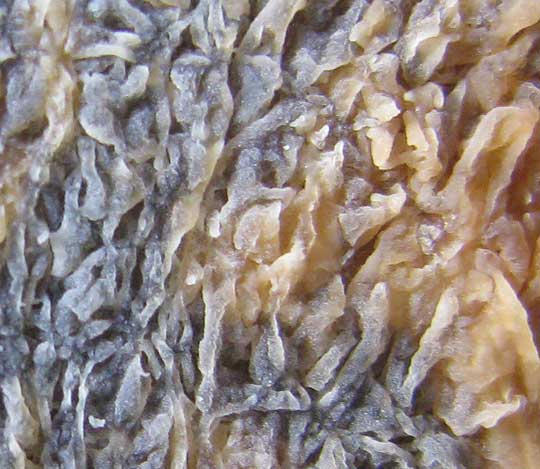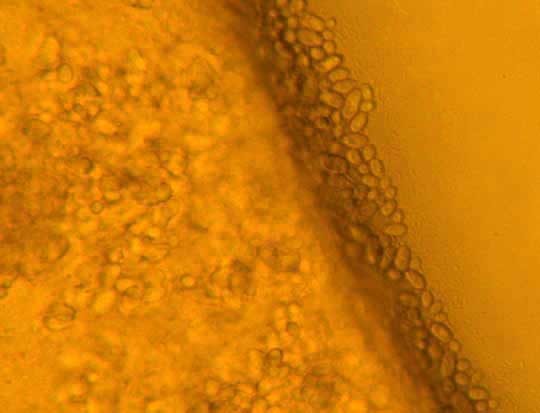Excerpts from Jim Conrad's
Naturalist Newsletter

from the June 15, 2014 Newsletter issued from the Frio Canyon Nature Education Center in the valley of the Dry Frio River in northern Uvalde County, southwestern Texas, on the southern border of the Edwards Plateau; elevation ~1750m (~5750 ft); N29.62°, W99.86°; USA
YEAST IN MY PEPPER JUICE
It all started when some guests at Phred's left behind a big bag of large, dried Guajillo Chili peppers. Apparently they'd wanted to grind the brittle skins into powder to make their own spicy barbecue sauce. I inherited the peppers, didn't want to make barbecue sauce, so each night I'd soak two or three to soften them up, then the next day add them to my omelets or sautéed creations. But when for a couple of days I skipped the soaking process, leaving out my soaking container. Before long an interesting scum formed atop it, shown below:

Wanting to see how this would develop, I let things continue. The next day the soaking juice's entire surface was white and the scum had developed intricate folding, as seen up close at the top of this page..
The next day the folds were collapsing and turning dark gray. I guessed that the scum was some kind of fungus and the dark parts were areas of spore production. A close-up of the scum at this stage appears below:

At this point I wanted to scoop some wrinkled scum onto a finger for examination under high magnification, thinking I'd see wrinkles composed of fungal hyphae sometimes producing spores. But when the wrinkles were touched they fell apart, leaving behind something like dust atop the water, shown below:

So, I looked at the "dust" with the microscope. At first I found nothing, looking for fungal hyphae with a fairly low magnification. However, after using higher and higher power, finally I saw what appears below:

You see see exceedingly small cells at the edge of a drop of pepper-soaking juice. Most cells are more or less egg-shaped, but some are longer, and these must be cells dividing asexually, forming new individuals. I assume that these are yeast cells, and pictures on the Internet of yeast cells of the kind that ferment fruit juices look just like these.
So, yeasts are members of the Fungus Kingdom, and about 1500 yeast species have been described so far. They are unicellular and species size varies greatly, typically measuring 3-4 µm in diameter, or 0.003 to 0.004mm, though some get larger than 40 µm, or 0.04mm.
A good bet is that our yeast is a member of the genus Saccharomyces, which is most commonly involved with fermenting fruit juices. Brewer's yeast or baker's yeast, often used as a B-vitamin food supplement, is a Saccharomyces. Saccharomyces cerevisiae, is used in making wine, bread, and beer. When Saccharomyces species ferment -- presumably what was going on in my pepper juice container -- they convert carbohydrates to carbon dioxide and alcohols. During my pepper soaking process, many simple carbohydrates must have seeped from the peppers into the water, offering yeast cells just what they needed.
Some yeasts cause diseases, such as the genus Candida, which causes an oral and vaginal infection in humans known as candidiasis. The yeast genus Cryptococcus attacks people whose immune systems are weakened, especially those with HIV/AIDS, causing over 600,000 deaths annually. However our pepper-juice loving Sacchoromyces yeast doesn't seem to attack humans, and I'm glad to cohabit with it, especially knowing that sometimes it forms such prettily folded white scum.